FURNACE MAINTENANCE
I reserved Saturday October 20, 2018 to do routine/preventative maintenance
on our oil furnace.

I am guessing the year 1978, when an outside cooling unit was installed,
Johnny Hildreth added additional return duct work to the plenum, of which
you can see on the upper left side of the furnace. There are two large
additional return vents in the hallway that leads into a chamber in one of
the closets in a small bedroom that ties into the large round duct work in
the above pix to provide adequate air return for the cooling system.
We replaced the outside cooling unit a few years back with a larger Trane
unit and you can see the addition to the plenum on the right side to
accommodate the larger A coil.
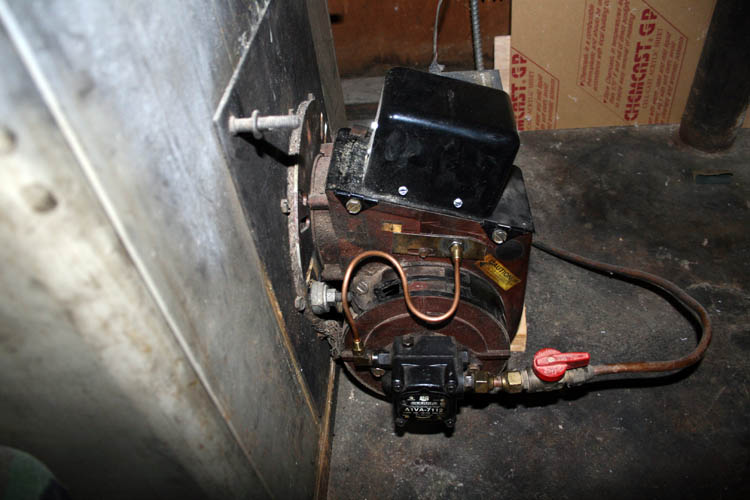
The used Thermo Pride Beckett model EASR burner is still working pretty good.
I didn't do any picture taking of the recent preventative maintenance simply because fuel oil and cameras don't mix
well and even with rubber gloves on, it is a fairly nasty job, whereas the
colored diesel fuel oil is very smelly too.
I raised the basement garage door to help get rid of any fuel oil smell
while completing the maintenance. You need plenty of rags or paper
towels and containers to keep fuel contamination down to a minimum. I use an old cake
pan underneath the burner fuel pump to catch fuel oil that drips out from
the fuel line from the fuel pump to the nozzle tube assembly. The
burner motor was oiled with light weight oil designated for such. I
changed an in line oil filter that goes into a General 1A-25 filter housing and the
replacement filter is a 1A-30 filter. I use a recycled stainless steel
Bunomatic coffee maker water reservoir positioned below the fuel filter
housing
to catch fuel oil when changing the filter. I have the filter assembly
inside the basement about 10 feet from the oil burner assembly adjacent the
back wall where the incoming fuel line is located. There
are cut-off valves on each fuel oil above ground tank and a cut-off value at
the fuel pump intake on the burner. The electrode assembly was removed
from the burner and the nozzle was replaced with a Steinen .75H. The electrodes were in
excellent shape being replaced on 11-06-16 and buffed each electrode tip
with 400 grit wet/dry aluminum oxide paper. The ceramic electrode
insulators
along with the holder were cleaned and cleaned the lens of the
cad cell that detects light from the burning flame which is a safety device
and will cut the burner off within forty-five (45) seconds if it doesn't detect a
flame. This keeps fuel oil build up in the brick lined firebox inside
the furnace in the event of non-ignition of the burner. Newer
model primary controllers will shut the burner down much faster which is a
better safety device.
Everything was put back together and gave it a test run and bled the air
from the fuel pump and fuel oil filter housing while the burner was operating.
Apparently many years ago, the wires going from the Honeywell furnace controller
terminals TT to the thermostat control topside were skinned back a
little to allow a jumper lead to be placed across them to start the burner.
If the cad cell does not sense flame, the primary control will shut the burner
down. When servicing the burner, sometimes you have to short out
terminals FF on the primary control to keep it from timing out if it
doesn't sense flame, but this allows fuel to be atomized into the fire box
and should be avoided.
FURNACE MAINTENANCE 2016
Below are some archived pixs from 2016 where I replaced the fuel line tubing
aka gun line from
the fuel pump to the electrode assembly, of which a service man years ago had
rounded the hex shaped brass nut using
channellock pliers. Any service
person with a pair of channellock pliers and an adjustable wrench
turning/tightening hex head bolts needs to
be run off your premises for not using the proper tools. Seems like
those folks want to take all the short cuts and I realize time is money for
them.
I can understand a plumber using a pair of channellock pliers on sink
drains and traps, etc., but that is about my limit for their usage. I definitely
do not want to use a pair of
channellock pliers on any
hex nut that can be eventually destroyed over time, whereby you cannot use a socket or
wrench on it. I have and do use a large pair of channellock pliers on
vehicle oil filters, but prefer the large "socket" type oil filter
wrench using a ratchet.
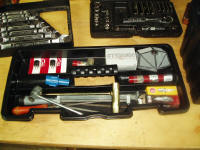
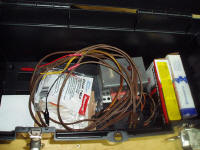

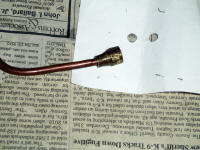
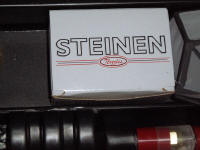
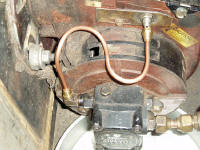
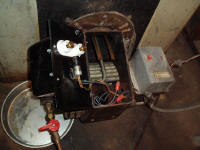
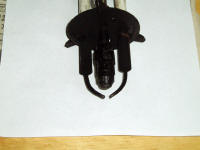
I keep my furnace small spare parts in a separate "tool box". I don't
have a dedicated nozzle wrench, but use a 3/4 inch open end box wrench and a
5/8 inch socket to remove the nozzle from the nozzle tube assembly.
The electrodes were replaced on 11-06-18 and don't think the nozzle was
replaced since the unit was firing properly after the new electrodes were
installed.
SPARE PARTS
I keep on hand a new spare ignition transformer, new spare blower motor, spare set
of electrodes, spare nozzles, spare cad cells and have an older Thermo
Pride/Beckett OEA burner
assembly for spare parts usage as well. I have a used spare Honeywell
R8184K primary control (now obsolete) for
the burner assembly and a spare new RMB Controls furnace transformer
relay controller 175-100101-10. I
recently ordered a couple Suntec SSC109 strainers for the fuel pump and sure the
strainer
needs cleaning and/or replacing, but since I don't have a spare gasket,
therefore I
will leave as is for now. The fuel pump gasket normally doesn't need replacing,
but Murphy's law
never sleeps. I will change the strainer and/or gasket ASAP.
On 11-13-18, I ordered a spare Suntec fuel pump being a Suntec A1YA7912
which replaced the original fuel pump Suntec A1VA7112. Hopefully, I
should have enough spare parts on hand should anything wear out and/or
malfunction needing to be replaced.
NOTE: I replaced the fuel pump strainer on 11-13-18 and it was
very, very dirty, therefore put a new nozzle in the firing gun tube assembly and
set the electrodes to specifications. I didn't replace the fuel pump
strainer gasket which was in good shape.
I also ordered a Firomatic shutoff valve with a long stem that screws
directly into the 1/4 inch NPT fuel pump upper intake and accommodates a
standard 3/8 inch flare input fitting for the copper fuel line. I will elevate
the fuel line off the floor and secure the copper fuel line to a wall stud adjacent the furnace and get
the fuel line in a position that does not present a safety hazard.
I also keep my spare chain saw parts in the same tool box, of which I need
to purchase another tool box just for my chain saw parts and accessories.
I need to replace the jury rig coupling between the fuel cut-off valve to
the intake of the fuel pump. It was put on there many years ago by a
service man who didn't have the proper fitting is my best guess. I believe I stepped
onto or
bumped into the fuel line and there was later a slow leak. I had to clean up
the mess and tightened the
couplings about as tight as I could in order to get the slow leak stopped.
When the Firomatic shutoff valve arrives, I will install it and will have to
add an additional piece of 3/8 inch copper tubing in order to secure the
fuel line off the floor onto one of the wall stud members which should get
the fuel line out of the way as far as stepping on it, etc. When
Johnny Hildreth and myself installed a new fuel line to the above ground
tanks install, we didn't have much extra tubing on hand if my memory is correct;
although enough to
get the job completed. I might hold off on the installation of
the Firomatic shutoff valve until the end of the heating season, unless
there has to be maintenance done on the furnace. The old saying,
"If it ain't broke, don't fix it"....grin
if you must!
I plan to check the pump pressure and if it is not holding or too low, will
replace the pump at the same time I install the Firomatic shutoff valve.
The furnace air filters are ok. I have two filters in the system that
are aluminum framed and able to wash and dry them with air pressure,
etc. They remove a lot of dust from the air, however they do restrict
the air flow some and replaced them with the 30 day disposable type during
the cooling season to get more air flow.
Hopefully, this old fuel oil system will last another heating season!
FURNACE HISTORY
When we purchased our home in 1989, the furnace used an underground
oil tank, however when the fuel level got down to about 12 inches from the
bottom of the tank, the system would loose its prime due to a single line
supply versus the two line supply which has the return line to the tank from
the fuel pump which automatically primes itself. The tank depth in the ground was the problem being
about level with the basement floor where the furnace is located. I
noticed there was a fill tube (priming tube) installed in the fuel line that
came through the basement wall, but that definitely was a temporary fix to
re-prime the system. Later, I installed a check valve, but that didn't
help out as far as the burner loosing its prime.
I later installed two 260 gallon above ground tanks in tandem which gives
plenty of gravity flow pressure and that eliminated the burner loosing its
prime with a single supply line to the fuel pump on the burner.
I had the original burner motor rewound by Roger Funderburke of Marshville,
NC (now deceased) and a heating system will normally fail at the coldest time of the
year.....grin if you must! We had to use an auxiliary heat
source (Kerosene heaters) and it was still very cold being only able to heat a couple rooms at
the most. Later, the phenolic adapter fitting that went from
the burner motor shaft to the fuel pump broke and it was so outdated, I could not
find a replacement part and the burner assembly was changed out by Johnny
Hildreth, Allen Hildreth and myself on 01-10-98 which is detailed below.
The original furnace Crane Sunnyland heat exchanger is still going
and this is the third burner assembly installed on the furnace. Our
neighbor and friend Johnny Hildreth and his son Allen replaced the original burner with a used
Thermo Pride Beckett model OEA that I purchased around 1995 from
Grover Tarlton
(now deceased) for spare parts. Johnny replaced the burner on 01-10-98
and it definitely was cold for sure. We had to modify the mounting
holes for the air tube flange that secured the burner to the furnace
mounting bracket.
The stack relay thermal switch controls were removed from the flu not being needed with the first
Thermo Pride Beckett replacement burner install on 01-10-98 which used the cad cell
technology for safety. The old stack control unit used a thermo couple
to detect heat and shut the burner down in case the fuel did not ignite.
The last burner was replaced by Marvin Goodwin of Lilesville, NC and
myself in 2012 was a Thermo Pride Beckett model EASR that was
used and it was recycled from the furnace removed from The Mt. Beulah Baptist
Church of which the heat exchanger was bad. I believe Marvin took the old OEA burner with him if I am not
mistaken. I did have some trouble very soon after the install with the cad cell
not sensing the flame
because the burner electrodes and gun tube were dirty and not reflecting
enough
light back to the cad cell of which the cad cell was working fine and would
shut the burner down. The burner that
came from The Mt. Beulah Baptist Church was set up for a two line in ground fuel system and
the by-pass plug was not initially removed from the fuel pump causing the
burner to soot up when we fired it up. It was making a terrible racket
trying to pump fuel, but was restricted by the by-pass plug being installed. We have a single line gravity fed system from the
above ground fuel tanks as stated earlier, therefore the by-pass plug has to
be removed from the lower right fuel intake port. I remembered from years ago, that Johnny Hildreth
had to remove the by-pass plug from the used OEA burner fuel pump that I
obtained from Grover Tarlton sometime around 1995 that he and
Allen installed on 01-10-98. I related that info to Marvin and the burner fired as it should
once the by-pass plug was removed from the lower intake. I am guessing
this caused the accumulation of soot in
the burner tube assembly which later caused the system to shut down.
I obtained a spare Thermo Pride Burner model OEA with an identical Honeywell
R8184K primary control from a furnace that was replaced with a heat pump a few blocks
from our home and swapped out the primary control, but the problem was a dirty
burner tube and electrode gun assembly not reflecting enough light back to the cad
cell. Those older Thermo Pride Beckett burners, OEA and EASR are now obsolete for
sure as well as some of the Honeywell primary controllers. Some service
personnel will paint the inside of the burner tube assembly white in order
to reflect more light back to the cad cell which makes sense.
With newer Beckett burners, the motor is running at 3450 RPM and the
ignition transformer is around 20K volts versus the older 10K volts and 1725
RPM main drive motor, of which the new burners are faster igniting and more efficient.
If I didn't have an array of spare parts for the older burner, I would
upgrade to the new Beckett burner.
I replaced the 3/16 inch diameter x 10 inch length nozzle fuel line aka
gun line on
October 3, 2014, of which the brass fitting to the flame gun tube was
damaged by earlier repairmen using Channel lock pliers. An 8 inch
length nozzle line will work fine, but I could only locate a 10 inch length
which has the brass flare fittings in place. There was other
maintenance done to the burner, but did not have any annotation in the
furnace maintenance file folder.
I installed the third motor for the squirrel cage fan on 06-25-17, of which
is now a 1/3 HP ball bearing motor versus the original 1/4 HP motor with sleeve
bearings. The squirrel cage blower has bronze bearings which gets
oiled a couple times a year with 30 weight motor oil.
Since 2012, I have been able to keep the furnace running and replaced
the ignition transformer on the third aka current used burner assembly since
2012 if my memory is correct.
I keep all my maintenance documentation in a file folder which has a diagram
of the original install of the Crane Sunnyland model upright basement furnace.
NOTE: CRANE stopped making HVAC products in 1968.
Furnace technology sold to Amana.
JOHNNY HILDRETH
Our friend and neighbor
Johnny Hildreth did most of our plumbing
and furnace maintenance until he passed away on 05-25-09. We certainly
do miss this kind and generous neighbor and friend. He taught me how
to maintain our furnace and that has been a big help since the current
generation HVAC men
in our area are lacking experience on the older fuel oil heating systems due to fuel oil
furnaces being replaced with heat
pumps and gas packs. Fuel oil systems are still much in demand in the
Northern cold climate zones with the fuel tank in the basement or underground
due to the sub freezing temperatures. I remember back in the 1970s at
the old home place on White Store Road, it was so cold outside that the
kerosene about froze and was the viscosity of Karo syrup rendering the
main Seigler oil heater practically useless due to not getting enough fuel
to the heating chamber.
When the heat exchanger does give up the ghost, I will no doubt go back with
a Thermo Pride fuel oil similar basement model furnace since we have a split
heating/cooling system in place.
Web page updated by Bill aka Mickey Porter on 10-20-18 with additional pixs
added on 11-06-18 and updates on 11-13-18.
FUEL OIL FURNACE MAINTENANCE
CONTINUED
Our fuel oil furnace the past couple years has been performing really
well and didn't perform and major maintenance, but lubricated the
squirrel cage fan bearings and also the drive motor for the burner.
However, I decided to do a complete routine annual maintenance on the
system; e.g., changing the in-line fuel filter, complete lubrication of
the squirrel cage fan blower bearings, drive motor for the burner,
cleaning the CAD cell lens and cleaning and inspection of the
burner gun.
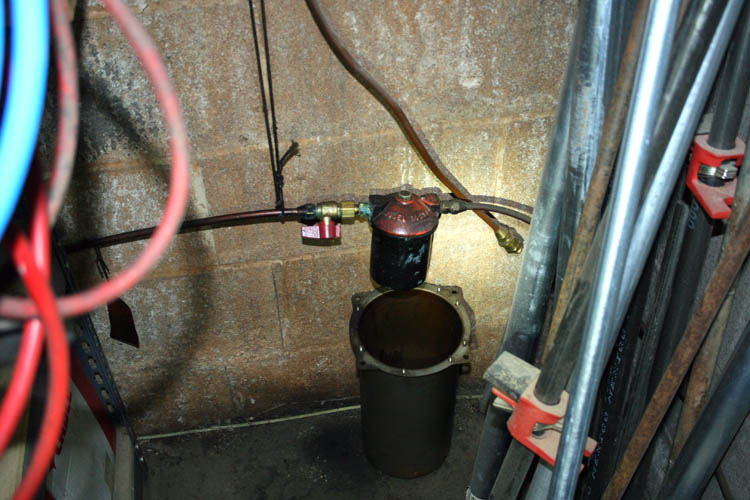
Above is pix of the in-line General filter system. I have an
ole Bun-a-matic water tank used as an oil catch when removing the base
unit of the General filter housing. There is also an in-line fuel
cut-off valve before the input to the General filter assembly.
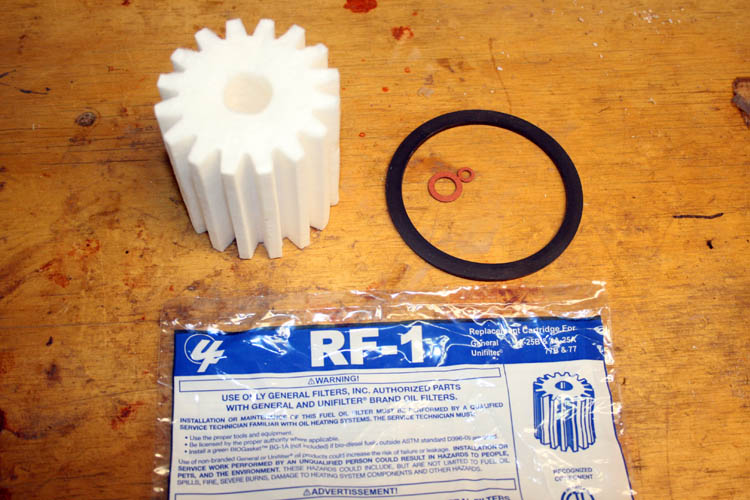
I elected to use a different filter replacement for the General fuel
filter.
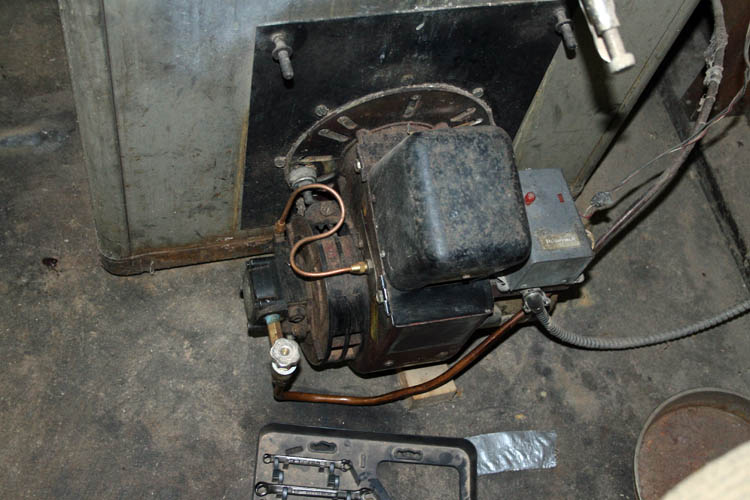
Pix of the old burner.
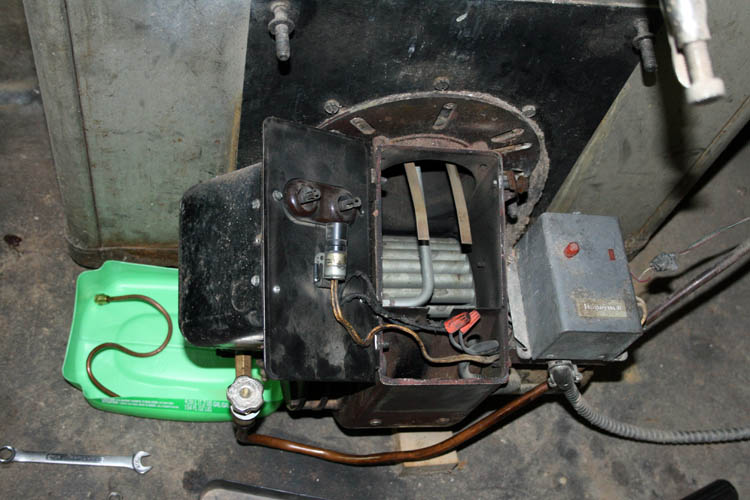
The fuel line to the "gun" assembly has been disconnected and you can
see the gun with the two brass spring type connectors attached to the
electrodes.
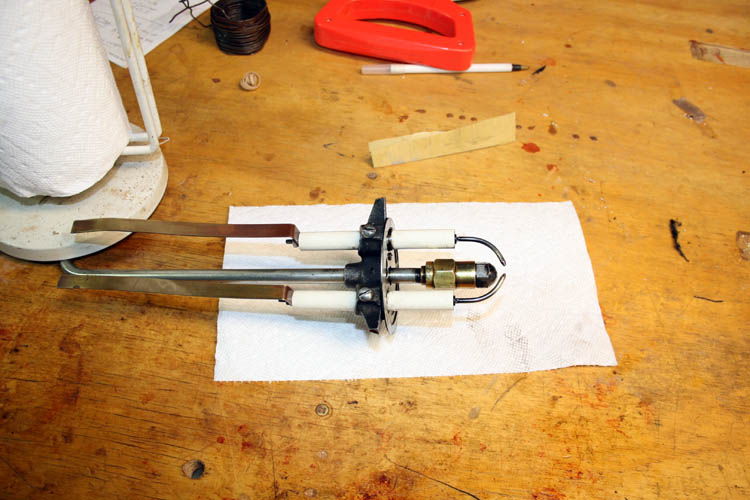
The gun above has been cleaned and soot removed from the ceramic
insulators, electrodes cleaned using 600 grit paper to freshen the tips
of the electrodes. The electrode gap was still properly set and
didn't need to adjust them. The unit has been firing without any
problem and no need to replace the nozzle, however most service
personnel will change the nozzle as part of the maintenance, where
needed or not. There is also a filter inside the nozzle input to
catch any small debris from the fuel oil line and there is also a filter
in the pump. With the in-line fuel filter from the tank, you have
triple protection from debris, etc., and I am sure
most of any particles will be captured before it reaches the burner
assembly.
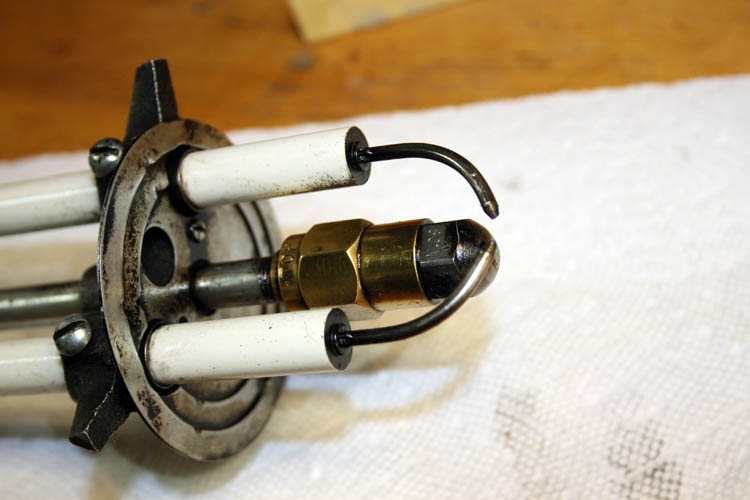
I put the gun back into the burner and connected the fuel line to the
burner pump, fired the unit up and opened the bleed valve to the fuel pump and let
fuel drain into a catch container and any air that was in the system
will be removed. Remember I opened the General fuel in-line filter
and let the housing fill back up with fuel and there is a small vent
screw on the filter housing just for that purpose also.
I fired the burner up and let it run and checked for fuel leaks and
everything was good. Cleaned up any fuel on the concrete basement
floor and hopefully will be good for another heating system. I
will change the air filter to the unit also and lubricate the squirrel
cage blower bearings again before it is time for the heating system to
come on line.
Web page updated by Bill aka Mickey Porter on 09-24-2023.
CORRECTIVE MAINTENANCE 01-23-2025
Back in the early fall of this year, 2024, I did a Reader's Digest
version of my furnace maintenance since it was running running real well
with no problems and figured it would be OK, my bad!
However, on the early morning of 01-23-2025 at about 4:00 AM my bride and
myself were having trouble sleeping (insomnia)
and got up, whereas she went to the bathroom and then to her recreation room
which has the TV and a lift chair. I noticed right off that the house
was cold and checked the thermostat and it was showing
60 degrees F. and the outside temperature was around
15
degrees F.
I got my clothes on and proceeded to diagnosis the problem and it was
found quickly the burner was no firing at all. I checked the arch
across the terminals of the ignition transformer and it was evident it was
not putting out enough spark. I had a spare Dongan XD-WN208
ignition transformer in reserve and replaced it.
I also removed the gun electrode assembly and cleaned it up and replaced
the nozzle with a new one and cleaned the CAD cell. I think I first
opened up the vent valve to the fuel pump and checked that it was pumping
oil, of which it was.
Everything was put back together and ran the unit and checked for leaks
and it was fine. Probably took an hour to complete and more than an
hour to get the house back up to 72 degrees F. Running good so far at
4:41 PM.
I have a friend getting me another ignition transformer as a back up.
The transformer that was in there was very old and can't remember where I
got it from.
Web page updated by Bill aka Mickey Porter on 01-23-2025.
CORRECTIVE MAINTENANCE 03-13-2025
On or about 03-13-2025, I noticed that the thermostat when reached the
proper setting, the controller unit would shut down and immediately would
come back on again and would cycle several times doing the same thing.
I would have to lower the thermostat setting in order to cut the controller
off which turns off the drive motor and fan to the burner.
Since I had never experienced this problem before, I called Marvin
Goodwin and he came over and changed out the original Sears thermostat.
However, during the night, the unit cycled off and on before and he came
over the next day and put the original thermostat back in and also swapped
out the controller with a new one. I normally keep spare parts for the
furnace on a lower shelf, however I could not locate the spare controller.
After Marvin installed the new controller R8184G 4009, the furnace
is working fine.


I took the liberty to look inside the old controller and the problem
could be any number of things.
Web page updated by Bill aka Mickey Porter on 03-16-2025.
LEAVING ON A SPIRITUAL NOTE
If you do not know Jesus Christ as
your Lord and Savior, please take this moment to accept him by Faith into
your Life, whereby Salvation will be attained.
Ephesians 2:8 - 2:9 8 For by grace are ye saved through faith;
and that not of yourselves: [it is] the gift of God: 9 Not of works, lest
any man should boast.
Hebrews 11:1 “Now faith is the substance of things hoped for, the
evidence of things not seen.”
Romans 10:17 “So then faith cometh by hearing, and hearing by the
word of God.”
Open this
link about faith in the King James Bible.
Romans 10:9 “That if thou shalt confess with thy mouth the Lord
Jesus, and shalt believe in thine heart that God hath raised him from the
dead, thou shalt be saved.”
Open this
link of Bible Verses About Salvation, King
James Version Bible (KJV).
Hebrews 4:12 “For the word of God is quick, and powerful, and
sharper than any two edged sword, piercing even to the dividing asunder of
soul and spirit, and of the joints and marrow, and is a discerner of the
thoughts and intents of the heart.”
Romans 6:23 “For the wages of sin is death; but the gift of God is
eternal life through Jesus Christ our Lord.”
Romans 3:23 “For all have sinned, and come short of the glory of
God;”
Micah 6:8 “He hath shewed thee, O man, what is good; and what doth
the LORD require of thee, but to do justly, and to love mercy, and to walk
humbly with thy God?”
Philippians 4:13 "I can do all things through Christ which
strengtheneth me."


